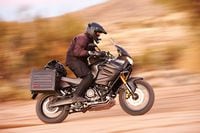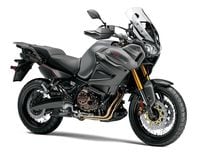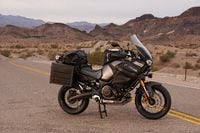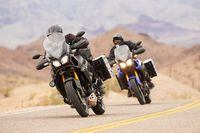Japanese manufacturers are having to work harder than ever to keep pace with the Europeans, and nowhere more than in the adventure-touring segment that has lately become the vanguard of motorcycle technology. No longer is it enough to just offer a high handlebar, loads of ground clearance, and rugged wheels and tires—any fit ADV must also deliver a sophisticated electronic suite including multiple drive modes, switchable traction control, ABS, and, increasingly, electronic suspension adjustment, too.
The Yamaha Super Ténéré already offered the requisite ride modes, ABS, and TC. For 2014, the Super T gets electronic cruise control on both the base and the new ES model that also adds electronically adjustable (but not dynamic) suspension to move it closer to competition like BMW's R1200GS, KTM's 1190 Adventure, and the Ducati Multistrada. Essentially identical to the KYB electronic suspension already available on Yamaha's FJR1300ES sport tourer, which uses small electric stepper motors to actuate the damping adjusters at the push of a button, this system offers four pre-load settings (rear only), three damping profiles (Soft, Standard, or Hard), and seven levels of fine damping adjustment (which are held even after you change profile or preload setting) to allow the rider to quickly and conveniently alter the suspension characteristics to suit any surface, load, or terrain. It's a comprehensive and rider-friendly system.
Suspension aside, the Super Ten remains largely unchanged from 2013. The compact, 1199cc parallel twin benefits from modest 2 horsepower and 1.5 pound-foot torque increases. Dual drive modes have been reprogrammed to provide a more pronounced difference in throttle response and power delivery between the Touring and Sport settings, and the corresponding traction-control schemes, with less intrusive intervention in Sport compared to Touring, modulate both ignition timing and fuel delivery for smooth management of rear wheel slip. Traction control can also be turned off completely, unlike ABS, which cannot. You can, however, override the Unified Braking System (UBS) that links the rear brake to the front lever just by pressing the rear brake lever first.
The cockpit benefits from additional changes, including a new, fuller-coverage shape for the adjustable windscreen and a relocated handlebar that is now 10mm higher and 10mm closer the rider. Seat height remains one-inch-adjustable as well. Three-level heated grips are included on the ES, and optional on the standard bike. Best of all for budget shoppers, the Super Ténéré offers all this technology at a significantly lower price than its the European competition, with the standard model priced at $15,090 and the upgraded ES selling for $16,190.
On the web: yamahamotorsports.com















/cloudfront-us-east-1.images.arcpublishing.com/octane/3TIWWRV4JBBOLDVGRYECVVTA7Y.jpg)
/cloudfront-us-east-1.images.arcpublishing.com/octane/KIX5O23D5NAIBGFXBN3327DKZU.jpg)
/cloudfront-us-east-1.images.arcpublishing.com/octane/7GJYDUIPXRGMTMQKN6ONYOLBOU.jpg)
/cloudfront-us-east-1.images.arcpublishing.com/octane/MUQLOVLL2ZDGFH25ILABNBXKTI.jpg)
/cloudfront-us-east-1.images.arcpublishing.com/octane/TNOU5DNE2BC57MFPMGN2EIDXAM.jpg)
/cloudfront-us-east-1.images.arcpublishing.com/octane/GTCXACQGJ5HAPDTGWUQKDEH44E.jpg)
/cloudfront-us-east-1.images.arcpublishing.com/octane/S35YGSEMEZB4BLTDJTSZPF4GLA.jpg)
/cloudfront-us-east-1.images.arcpublishing.com/octane/5UOT6HPX2JFMRJAX6EH45AR4MQ.jpg)
/cloudfront-us-east-1.images.arcpublishing.com/octane/OKWOJWAKP5EP3OACCRRWPCIX2Q.jpg)
/cloudfront-us-east-1.images.arcpublishing.com/octane/2WF3SCE3NFBQXLDNJM7KMXA45E.jpg)
/cloudfront-us-east-1.images.arcpublishing.com/octane/G4MG6OUCJNBSHIS2MVVOTPX65E.jpg)
/cloudfront-us-east-1.images.arcpublishing.com/octane/IIGGWFOTOJGB7DB6DGBXCCMTDY.jpg)
/cloudfront-us-east-1.images.arcpublishing.com/octane/QSTCM6AVEZA5JJBUXNIQ3DSOF4.jpg)
/cloudfront-us-east-1.images.arcpublishing.com/octane/U4I7G625B5DMLF2DVIJDFZVV6M.jpg)
/cloudfront-us-east-1.images.arcpublishing.com/octane/B6XD6LS6IVCQPIU6HXDJSM3FHY.jpg)
/cloudfront-us-east-1.images.arcpublishing.com/octane/ICL63FEDDRDTTMINYICCEYGMDA.jpg)
/cloudfront-us-east-1.images.arcpublishing.com/octane/FCGZHQXRBZFLBAPC5SDIQLVF4I.jpg)
/cloudfront-us-east-1.images.arcpublishing.com/octane/WNOB6LDOIFFHJKPSVIWDYUGOPM.jpg)

/cloudfront-us-east-1.images.arcpublishing.com/octane/X33NU3E525ECRHXLNUJN2FTRKI.jpg)
/cloudfront-us-east-1.images.arcpublishing.com/octane/6KKT5NNL2JAVBOXMZYS5ZO76YA.jpg)
/cloudfront-us-east-1.images.arcpublishing.com/octane/J5RKG5O455GMPGQRF2OG6LRT7A.jpg)
/cloudfront-us-east-1.images.arcpublishing.com/octane/GX2CIZKQVRH2TATDM26KFG2DAE.jpg)